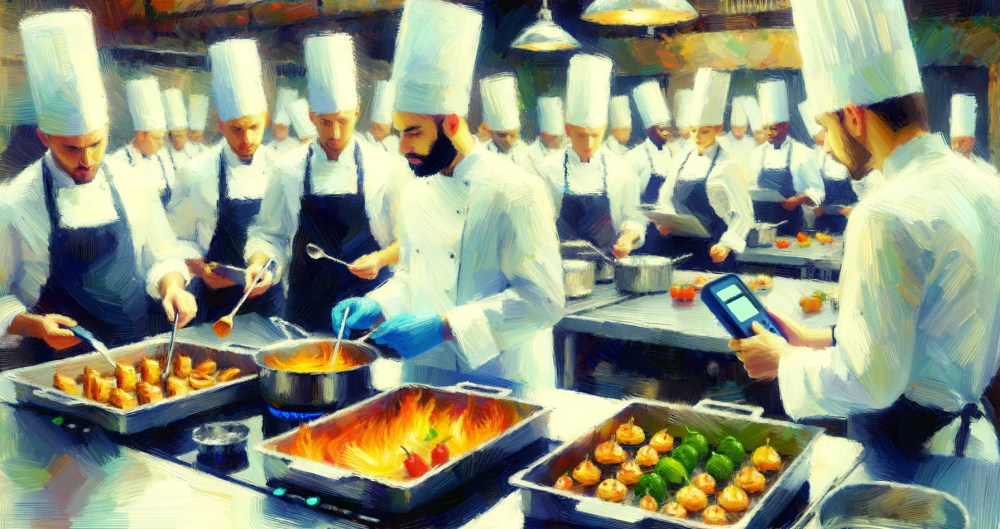Making sure your food gets really **hot** inside is super important for safety. Heating food properly wipes out those nasty **germs** causing stomach aches. The best way to tell if your food is **hot** enough? Use a food thermometer. Simple as that!
Why Internal Food Temperatures Matter
Pathogens like Salmonella, E. coli, and Listeria contaminate many food types, from raw meat and poultry to eggs and produce. While bacteria dies when it’s exposed to high heat environments, dangerous microbes can survive in undercooked food.

Source – https://www.fda.gov/media/107000/download
Cook meats to their recommended internal temperature by using a food thermometer. Safely cooked and ready to eat food have been heated past their designated temperature danger zone:
| Food Type | Safe Minimum Internal Temperature |
|---|---|
| Beef, Pork, Veal, Lamb, Bison, Goat, Rabbit | |
| – Steaks, roasts, chops | 145°F (63°C) with a 3-minute rest time |
| – Ground meat and sausage | 160°F (71°C) |
| Poultry (Chicken, Ground Chicken, Turkey, etc.) | |
| – Whole bird, breasts, legs, thighs, wings, ground poultry, giblets, stuffing | 165°F (74°C) |
| Eggs | |
| – Whole eggs | Cook until yolk and white are firm |
| – Egg dishes (e.g., frittata, quiche) | 160°F (71°C) |
| Fish & Shellfish | |
| – Fish (whole or filet) | 145°F (63°C) or until opaque and separates easily |
| – Shrimp, lobster, crab, scallops | Cook until flesh is pearly or white, and opaque |
| – Clams, oysters, mussels | Cook until shells open |
| Ham | |
| – Uncooked (fresh, smoked or precooked ham) | 145°F (63°C) with a 3-minute rest time |
| – Fully cooked (to reheat) | 140°F (60°C) for USDA plants, 165°F (74°C) for others |
| Casseroles | 165°F (74°C) |
| Leftovers of Other Foods | 160-170°F (74°C) |
1. https://www.foodsafety.gov/food-safety-charts/safe-minimum-internal-temperatures
2. https://www.fsis.usda.gov/food-safety/safe-food-handling-and-preparation/food-safety-basics/safe-temperature-chart
Use a Food Thermometer
Oven, fridge, and freezer temperatures fluctuate. Appliance thermometers monitor food temperatures to prevent foodborne illnesses like food poisoning. They also make sure your appliances are functional enough to heat perishable food past its temperature danger zone.

You cannot determine doneness by checking color and texture. Monitoring temperatures is critical for killing pathogens that may be present.
Refrigerators should always maintain a temperature of 40°F or below. Freezers work best at 0°F or lower. Ovens should preheat to the baking temperature called for in a recipe. Relying solely on appliance settings without verifying with a thermometer can lead to unsafe food temperatures.
Always use a clean food thermometer to check temperatures in the thickest part of the food. Steer clear of bones, fat, or gristle. Resting times allow temperatures to equilibrate after cooking.
Freezer & Refrigerator Temperature
Proper storage and reheating of leftovers is also essential to prevent foodborne illnesses. After cooking meats, poultry, and other foods, refrigerate perishable leftovers within 2 hours – do not leave them sitting out at room temperature. Place leftovers in shallow containers and refrigerate or freeze the food directly after serving.
When reheating refrigerated leftovers, thoroughly heat them to an internal temperature of 165°F or until steaming hot. Use a food thermometer to verify the internal temperature reaches 165°F.
Allow a standing time of at least 2 minutes after microwaving so the heat can evenly distribute throughout the food. Bring sauces and soups to a boil when reheating. Taking these steps when storing and reheating leftovers reduces the risk of foodborne illness.
Tips to Thaw Frozen Food Safely
When thawing frozen foods, bacteria can begin to multiply if food reaches unsafe temperatures. Use one of these safe methods to thaw:
- Refrigerator – For slow thawing, place food in the refrigerator. This keeps food at a safe, cold temperature while it thaws over the course of a day or two.
- Cold Water – For faster thawing, seal frozen food in a plastic bag and submerge in cold tap water that is changed every 30 minutes. Cook food immediately after it thaws.
- Microwave – Thaw food in the microwave if you will be cooking it immediately afterwards. Follow recommended defrost settings based on your microwave wattage. Use a food thermometer after cooking to make sure food reaches a safe internal temperature.
Do not thaw foods at room temperature or in hot water. This allows the exterior to reach unsafe temperatures. Additionally, do not refreeze food once it has completely thawed. You can prevent illness from the growth of bacteria by controlling temperatures during the defrosting process. Only thaw what you plan to immediately cook and eat.
Importance of Cold Food Safety Temperatures
Maintaining proper cold storage temperatures for foods is an important way to prevent bacteria from multiplying to unsafe levels. Keep refrigerator temperatures at or below 40°F. The freezer temperature should remain at 0°F. These cold temperatures slow down bacteria’s growth and keep food safe.
Use appliance thermometers to verify that your refrigerator and freezer are maintaining appropriate temperatures. Check appliance thermometers regularly, at least once per week. They allow you to monitor temperatures so you can adjust settings as needed to keep refrigerator and freezer temperatures in the safe zone.
Always cook meats, poultry, and other perishable foods to safe internal minimum temperatures as measured by a food thermometer. Refrigerating perishables within 2 hours and reheating leftovers thoroughly to 165°F also helps keep food safe. Maintaining refrigerator and freezer temperatures of below 40°F and 0°F prevents bacterial growth.

